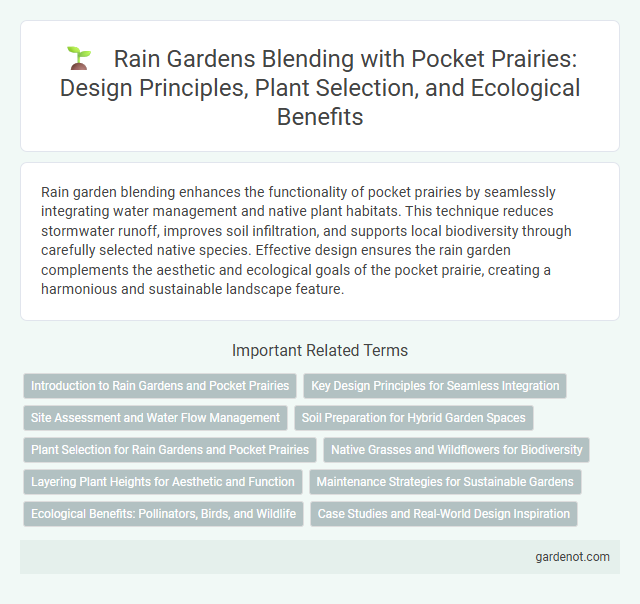Rain garden blending enhances the functionality of pocket prairies by seamlessly integrating water management and native plant habitats. This technique reduces stormwater runoff, improves soil infiltration, and supports local biodiversity through carefully selected native species. Effective design ensures the rain garden complements the aesthetic and ecological goals of the pocket prairie, creating a harmonious and sustainable landscape feature.
Introduction to Rain Gardens and Pocket Prairies
Rain gardens effectively manage stormwater by capturing runoff and promoting infiltration through native plants, reducing erosion and improving water quality. Pocket prairies mimic natural prairie ecosystems with deep-rooted grasses and wildflowers, enhancing biodiversity and soil health in small urban spaces. Combining rain gardens and pocket prairies creates sustainable landscapes that support pollinators, mitigate flooding, and contribute to ecological resilience.
Key Design Principles for Seamless Integration
Rain garden blending in pocket prairies relies on key design principles such as native plant selection, soil permeability, and appropriate grading to ensure natural water infiltration. Strategic plant layering combines deep-rooted prairie grasses with moisture-loving rain garden species to enhance biodiversity and manage stormwater effectively. Incorporating gentle slopes and mulching techniques promotes seamless integration while preventing erosion and optimizing aesthetic appeal.
Site Assessment and Water Flow Management
Rain garden blending in pocket prairies requires precise site assessment to evaluate soil type, slope, and existing vegetation, ensuring optimal plant selection and placement. Effective water flow management involves designing contours and drainage paths that capture and slow runoff, promoting infiltration and reducing erosion. Integrating native plant species adapted to local hydrology enhances the garden's ability to filter pollutants and sustain groundwater recharge.
Soil Preparation for Hybrid Garden Spaces
Effective soil preparation is crucial for rain garden blending in pocket prairies, ensuring optimal water infiltration and plant health. Incorporating organic matter and amending heavy clay or sandy soils improves soil structure, enhances moisture retention, and supports diverse native plant roots. Proper soil grading directs runoff into hybrid garden spaces, maximizing pollutant filtration and reducing erosion.
Plant Selection for Rain Gardens and Pocket Prairies
Selecting native, deep-rooted plant species such as purple coneflower, switchgrass, and blue flag iris enhances rain garden and pocket prairie filtration capacity by improving soil permeability and water retention. Incorporating a diverse mix of wildflowers and grasses adapted to local hydrology supports habitat for pollinators and maintains seasonal interest while minimizing maintenance. Strategic plant placement, with moisture-tolerant species in low-lying areas and drought-resistant varieties on higher ground, optimizes rainwater absorption and reduces runoff.
Native Grasses and Wildflowers for Biodiversity
Rain garden blending with native grasses and wildflowers enhances biodiversity by creating habitats that support pollinators, birds, and beneficial insects. Incorporating species such as little bluestem, switchgrass, black-eyed Susan, and coneflowers promotes soil health and natural water filtration. These native plants adapt to local conditions, reducing maintenance while fostering eco-friendly landscape resilience.
Layering Plant Heights for Aesthetic and Function
Layering plant heights in rain garden blending enhances both aesthetics and ecological function by creating visual depth and optimizing water absorption. Tall plants at the back, medium-height perennials in the middle, and groundcovers in front establish a natural gradient that supports pollinators and improves runoff filtration. This strategic arrangement not only beautifies pocket prairies but also maximizes soil erosion control and habitat diversity.
Maintenance Strategies for Sustainable Gardens
Rain garden blending in pocket prairies enhances water infiltration and supports native plant biodiversity by employing native grasses and wildflowers that require minimal irrigation. Maintenance strategies include regular mulching to suppress weeds, annual pruning to promote healthy growth, and seasonal monitoring for invasive species to maintain ecological balance. Implementing rain garden blending reduces runoff and supports sustainable garden ecosystems through natural filtration and habitat provision.
Ecological Benefits: Pollinators, Birds, and Wildlife
Rain gardens integrated into pocket prairies create vital habitats that support diverse pollinators such as bees, butterflies, and hummingbirds. This ecological synergy enhances local biodiversity by providing food sources and shelter for birds and small wildlife, improving ecosystem resilience. The native plant species used in these rain gardens promote natural water filtration while sustaining the wildlife populations essential for healthy urban environments.
Case Studies and Real-World Design Inspiration
Rain garden blending techniques in pocket prairies enhance stormwater management while supporting native biodiversity and soil health. Case studies from urban and suburban landscapes demonstrate successful integration of rain gardens using deep-rooted native plants like switchgrass and little bluestem, which improve water infiltration and habitat quality. Real-world design inspiration highlights layered planting strategies and erosion control measures that maximize ecological benefits and aesthetic appeal in diverse environmental conditions.
Rain garden blending Infographic

 gardenot.com
gardenot.com